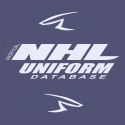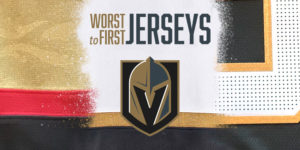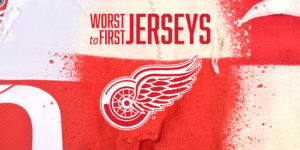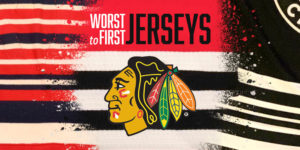HbD Interviews: Daniel Price (Colorado Avalanche & Phoenix Coyotes)
After having the pleasure of talking with Terry Smith, the designer of the San Jose Sharks logo, I jumped at the chance to talk to Daniel Price, designer of not one but two NHL logos currently being used, the Colorado Avalanche (which I ranked 29th) and the Phoenix Coyotes (which I ranked 9th), which I hoped would even me out in his eyes. As it turns out, he was great to talk to and didn’t harbour any ill-will towards me at all…I think. We had a great conversation, specifically about the huge difference between the development process between these two logos he created.
As some background, when he created the Avalanche logo, he was actually working with the Avalanche organization. When he created the Coyotes logo, he was running his own design company, Adrenalin, based out of Colorado, and was hired by the Coyotes organization.
And now, here’s our conversation…
HbD: What can you tell me about the logo-making process in general for sports teams?
Dan Price: It depends on the league really. There are some teams who will put the brand of their team last. They’ll go out and figure out everything they need from building locations to coaches, etc. They’ll start thinking about everything but their logo, and then at the last minute, they decide they need one. At that point, it’s usually last minute and there’s not enough time to do the necessary research, not a large enough budget, and it goes on and on. But, that is typically a challenge when you’re working on a logo like that because you’re often dealing with someone who doesn’t always understand what goes into a logo and a lot of times, the importance of it.
HbD: I honestly find that a bit surprising, as I’ve always thought that the main way a team is going to connect with their fan base is through their logo and through their brand.
DP: Brands last forever, players don’t. You can build your brand around your players or you can build your brand and determine who your players are going to be. That is a lot of what goes into a sports logo. You need to ask the organization that if you’re going to define the personality of their company, you need to know what type of players they’re going to go after. Are they the type of team that’s going to win at all costs? In other words, you they bring in a guy who they know is going to end up on the wrong side of the news half the time, but they don’t care because he can score fifty goals. Or are they the type of team that is more concerned with the quality of the personnel building a brand in their town, not going to cut corners, not going to bring in thugs and going to do all the things right. If you can really get into that type of conversation with somebody, then you can give a lot more thought to developing the logo. There are people that will say to you when building a brand that they don’t actually want it to look too expensive. They want it to look home-grown. If that’s the objective, and that’s what you get in the end, then it’s a good logo.
HbD: And did any of all this come into play in relation to your experience with your design of the Avalanche logo? For example, I remember reading an article where it was mentioned that there was a severe time constraint in the design of the logo. Was this more from an issue of ownership not being interested in the logo as much, or because of the move from Quebec City?
DP: The time constraint came from when we bought the team. We bought the team in May, and there were legalities to be worked though, but from the moment we bought the team, it was full steam ahead with selling tickets and designing the logo. There was a very short timeframe, but the logo and brand was definitely a priority.
HbD: And were there influences from the ownership or management team regarding the styling of the logo, like more home-grown, or based on the personality of the players, as you mentioned earlier?
DP: No, there was some conversation about it, but it wasn’t to the level that it could be because of the time frame. With the Avalanche, the earliest challenge was figuring out what the team name was going to be. They wanted to do a fan-based “name-the-team” contest, which needed a whole media campaign. So, we couldn’t start on the logo until we had a name, and we didn’t have a name until we went through that process. There was a very detailed, intricate planning with the logo, but of course we had to wait for the results. We were up against our own deadlines based on the way we wanted to do it. We could have just decided the name ahead of time and got a headstart on the logo development, but we made the decision to involve the public.
HbD: I understand that for the Avalanche, there was a name being played with at first, the Rocky Mountain Extreme?
DP: There was an idea for that name, and there were some people within the organization who wanted to play off the popularity of the X-Games and that genre to try and go after the younger and more aggressive demographic. Part of that may have been there was a concern that hockey hadn’t survived previously in Denver. But, once we reviewed it a bit, we decided not to go in that direction and do something a little more traditional.
HbD: So, with such a tight timeline, what did you want to focus on with the Avalanche logo?
DP: One of the focus points though was to ensure that it was something very regional. That was key. I love teams like the Miami Dolphins and the New Orleans Saints. For example, the New Orleans Jazz and Minneapolis Lakers made a lot of sense, but the Utah Jazz and LA Lakers makes no sense. In terms of the Avalanche, nobody else is going to pick that up aside from teams that may be located close to the Rockies, so it gave us a unique identity.
HbD: Looking back on the process of the Avalanche logo, are you happy with how it went considering the short timeframe?
DP: I judge logos by how they look on the ice and how they look in a quick photo and I think the Avalanche logo is very vibrant and easy to see. There’s other ones that you need to study a bit to determine which team is playing, so in that sense, I think the logo is still one of the top in the league. I would put the Coyotes logo in that same range.
HbD: And both the Avalanche and the Coyotes have very unique colour schemes compared to other teams in the league. I’m assuming that was a very conscious decision then?
DP: Yes, the colouring on both was a very conscious decision. One of the big decisions when you’re working on a logo at a national level like that, you want to make sure that your colours are unique. You don’t want to come out of the gate with yellow and black, like the Penguins and the Bruins, for example. When you do a logo on that scale, you look at all of your competition because you don’t want to be on the ice wearing the same colours as your competition. That was a major consideration for the development of the Avalanche.
For the Coyotes, we did the research to find out what people liked about the original logo and making sure that was reflected in the new logo. One of the things that the research found was that they really like the colours because it was regional to the desert, but they felt the old logo had way too many colours, so some needed to be eliminated. So, did we choose burgundy solely because it would look good on the ice? No. Did we choose burgundy because we knew a lot of teams weren’t using it and it would look good on the ice? Yes. There was a lot of conversation that went into the colours on both logos, but they were different types of conversations.
HbD: Were there any issues from suppliers and vendors for using somewhat unconventional colours for the logos and uniforms?
DP: Well, there’s always going to be small variations in colours between the suppliers. If the t-shirt vendor, for example, says that they have red and they have burgundy, you go with what they have. You absolutely take that into consideration in the logo development, but you can only control it so much. You could walk into an arena and see a burgundy vinyl, a burgundy embroider, a burgundy silkscreen, a burgundy cotton and burgundy on TV, and they’re never going to be same.
Hbd: Seeing how little time you have with the Avalanche logo, in contrast, how much time did you dedicate to the Coyotes logo?
DP: We spent just shy of 18 months on the Coyotes. I would love that amount of time for all logos, but the Coyotes went through an ownership and president change which probably tacked on a few months. But that also included gloves, jerseys, helmets, the works. The logo itself would be about 12-13 months of the 18 months. During that time, we approached about 12 rounds of revisions of the logo from original concept to finished product. Some of them were very minor, maybe a colour tweak, though.
HbD: With the revisions then, did you have a similar style throughout the process, or did it vary widely between the first version to the final one?
DP: When we went into the Coyotes pitch, they asked that we come in with a couple concepts, which included the whole visual brand (including secondary logo, jerseys, etc), but when we talked to them, we said that we didn’t know how we could do what they asked because we didn’t know what people liked or disliked about their original logo. There was a group of people in management there that wanted to change the logo, but nobody had talked to their fans to see if they wanted to change it. I wanted to determine if there was a need to change the logo before we changed it, and the organization, in the end, agreed with that. But, did the final logo end up being close to what was originally pitched? Yes, it was very close, but it was proven, studied and researched, and that’s why it was successful. I wouldn’t have had the confidence to go into the meeting with the original concept, them liking it, and end of story. But because of the research we did, when we launched the logo, I knew it would be successful. When you relaunch a logo as opposed to launching a new one, people will make comparisons. When we did the Avalanche logo, there was no other Avalanche logo we were being compared to. With the Coyotes logo, we had to consider whether people would like the new logo more than the old one. And the general public loved it because we did what they asked.
HbD: Any other important aspects of the development of either the Avalanche of Coyotes logos you would like to share?
DP: One thing is, for the Avalanche logo, we had a lot more input from the league. They were very much working with us on it. I was working with the team at that point, and we were always talking with the league. For the Coyotes, that wasn’t the case. I was with Adrenalin at point, so the Coyotes might have been talking with the league, but I wasn’t. The key thing to all these logos is understanding what your story is behind them and launching them with a purpose. If you’re going to spend the money to do a logo and you know it’s going to be around for a long time, you better consider the shelf-life, the merchandise and implementations and the revenue side of it as being huge. If you take everything into consideration and do the proper research, the launch and the logo will be successful.
HbD: Finally, in the spirit of the blog, what would you consider to be the best logo in the league?
DP: Well, I’m biased. I like the Coyotes logo the best. You have to give the Blackhawks credit for its longevity and its been very successful, but I would never do a logo like that. I think Minnesota did a great job, and I also like the Canadiens logo. But, if I were to rank the top 4 or 5, I’d say Boston, Calgary, the Avalanche, the Coyotes and the Devils.
Much thanks to Dan for doing this interview and giving insight into the process behind the logos of the Avalanche and the Coyotes. You can go check out his website at Adrenalin at www.goadrenalin.com.















Neat stuff, thanks for sharing.
Nice job! It’s very interesting to get the designer’s take.
I still don’t like the Coyotes’ logo, though.
[…] They threw out the complexity of the blatant Indigenous-inspired designs in favour of something that simplified the colour scheme to the burgundy and sand. They simplified the logo to something more elegant and refined, while still being distinctive. You can read the entire breakdown of the logo in the BTLNHL Countdown, and you can read the conversation I had with the designer of the logo, Daniel Price, here. […]
[…] Note: If you’d like to know more about the stories behind the design of the original Avs logo and jerseys, we did an interview with the designer, Daniel Price, which you can read here. […]
[…] • More: HbD Interviews: Daniel Price (Avalanche & Coyotes) […]
[…] • More: HbD Interviews: Daniel Price (Colorado Avalanche logo designer) […]
Hiya, I am really glad I have found this information. Nowadays bloggers publish only about gossip and net stuff and this is actually frustrating.